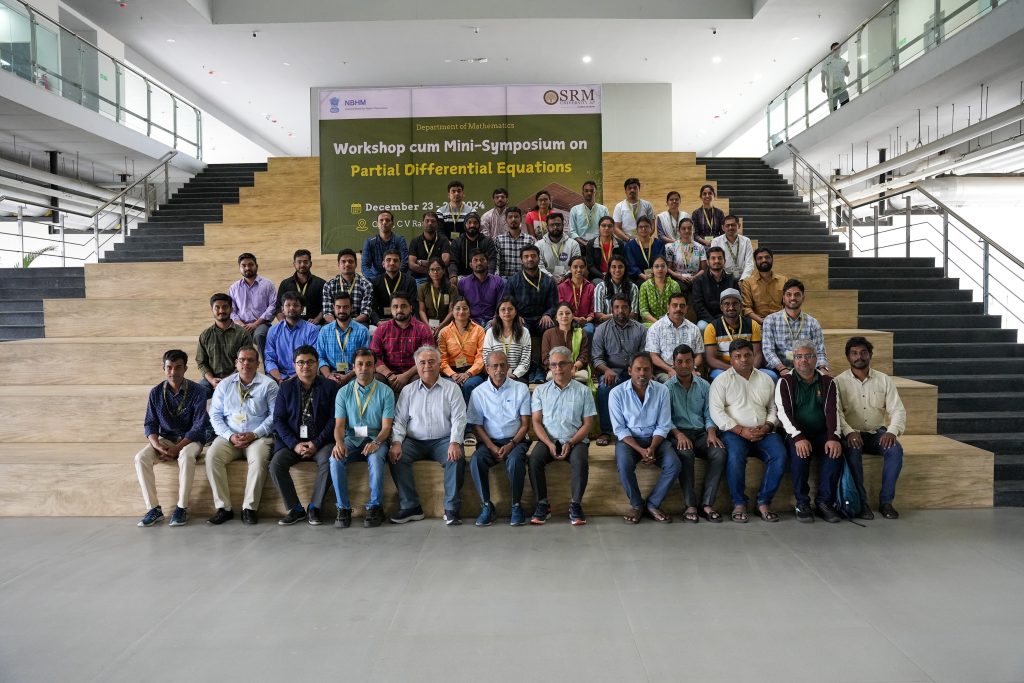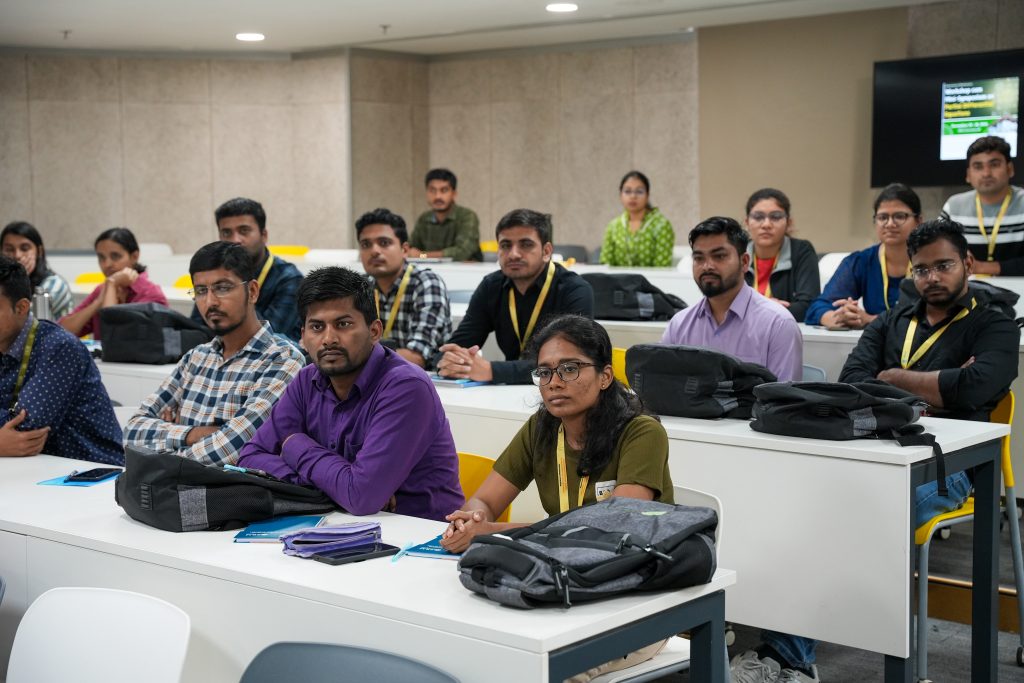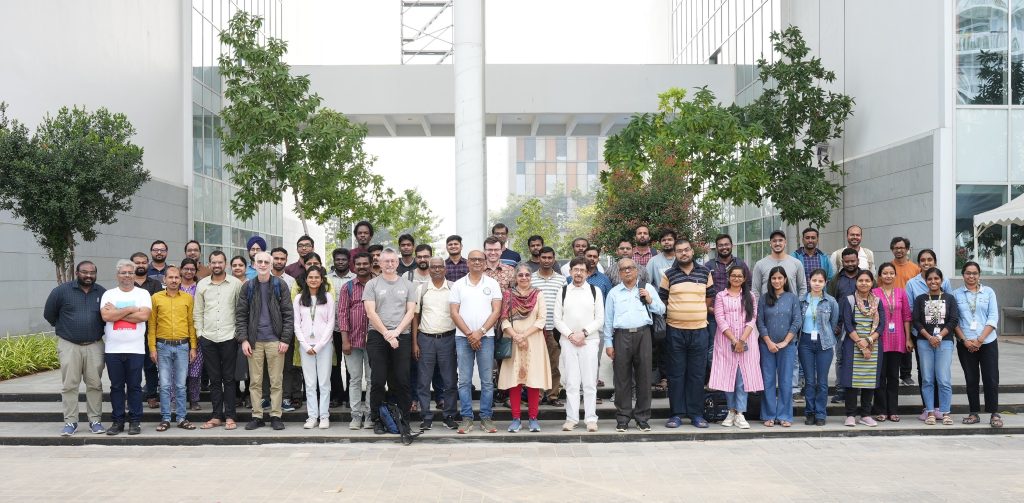Recent News
- Dr Kaur Explores New Frontiers in Mathematics February 6, 2025
 Dr Surinder Kaur, Assistant Professor at the Department of Mathematics is making significant contributions to the mathematical community and SRMAP’s research wing, her research on understanding the group rings and addressing challenges such as the isomorphism problem for group algebra through her project has earned her a funding of ₹ 4.28 lakh from the prestigious National Board for Higher Mathematics (NBHM). Dr Kaur’s impressive research work has become a source of inspiration to many. Given below are some details on her project titled, “On the group rings, their unit groups and some related questions”
Dr Surinder Kaur, Assistant Professor at the Department of Mathematics is making significant contributions to the mathematical community and SRMAP’s research wing, her research on understanding the group rings and addressing challenges such as the isomorphism problem for group algebra through her project has earned her a funding of ₹ 4.28 lakh from the prestigious National Board for Higher Mathematics (NBHM). Dr Kaur’s impressive research work has become a source of inspiration to many. Given below are some details on her project titled, “On the group rings, their unit groups and some related questions”A Brief Description of the Project
In this project, we aim at obtaining the structure and generators of the unit group of some group rings with a focus on answering the normal complement problem for them. Our further goal is to solve the celebrated isomorphism problem for group algebras of certain classes of groups, especially the twisted version of this problem for group algebras of nilpotency class at least 3. We also plan to look into certain questions in the representation theory of association schemes that are driven by what happens for group algebras.
Explanation of Research Objectives in layperson’s terms
In the last century, the work of E. Noether, F.G. Frobenius and R. Brauer have established that group rings play a central role in the development of representation theory. Further investigations indicated that these objects also have a great influence on the study of other areas of Mathematics like algebraic number theory, algebraic K-theory and algebraic topology. Moreover, the vital role it has played in the recent development of homological algebra and algebraic coding theory is worth acknowledgement.
Continue reading → - 6-Day Workshop cum Mini-Symposium on PDE Successfully Concludes February 5, 2025

The Department of Mathematics successfully hosted a 6-day Workshop cum Mini-Symposium on Partial Differential Equations (PDE) from December 23 to 28, 2024, with generous financial support from the National Board for Higher Mathematics (NBHM). The event aimed to bridge theoretical foundations and cutting-edge applications of PDEs, fostering academic dialogue among researchers, scholars, and students.
The Workshop held on the theme “Basics of regularity theory of elliptic partial differential equations” featured sessions by subject experts including Prof. A. Adimurthi, Visiting Faculty, Department of Mathematics and Statistics, IIT Kanpur; Dr Karthik Adimurthi, Reader, Tata Institute of Fundamental Research Centre for Applicable Mathematics, Bangalore and Prof. Prosenjit Roy, Professor, Department of Mathematics, IIT Kanpur.
Themed “Applied Mathematics Symposium on Differential Equations: Theory, Computation, and Beyond”, the mini-symposium featured insightful talks by Prof. Mohit Dalwadi, Associate Professor in Applied Mathematics, Mathematical Institute, University of Oxford; Dr Satyajit Pramanik, Assistant Professor, Department of Mathematics, IIT Guwahati and Dr Moitri Sen, Assistant Professor, Department of Mathematics, NIT Patna. These experts delivered lectures on advanced topics, including elliptic PDE theory, computational methods, and interdisciplinary applications.
The primary aim was to provide participants with a comprehensive understanding of the abstract theory of elliptic partial differential equations, emphasising both foundational principles and modern computational techniques. Interactive sessions, problem-solving workshops, and collaborative discussions enriched the learning experience.

The event witnessed enthusiastic participation from 23 outstation researchers (from reputed institutions across India) and PhD scholars from the Department of Mathematics, SRM AP. The diverse cohort facilitated vibrant academic exchanges and networking opportunities.
A special felicitation ceremony was also held on December 24, 2025, to honour Vigyan Shri Prof. Adimurthi for his monumental contributions to mathematics. This segment underscored SRM AP’s commitment to celebrating excellence in scientific research. The Workshop cum Mini-Symposium served as a dynamic platform for disseminating knowledge, fostering collaborations, and inspiring future research in PDEs.
Continue reading → - A Critical Review in Understanding Equity and Social Justice in Mathematics Education January 28, 2025

Dr Jayasree Subramanian, Associate Professor from the Department of Mathematics, has recently published a book chapter titled “Strengthening Equity and Social Justice Research in Mathematics Education Through Critical Interrogations of White Supremacy and Settler Colonialism” in the Fourth International Handbook of Mathematics Education by Springer Publications.
Abstract
In this chapter, we contextualise a suggested approach to strengthening equity and social justice research in mathematics education by inserting the mathematics education enterprise into two world events of 2020: the global COVID-19 pandemic and the global resurgence of the Black Lives Matter movement. Our intent in doing so is to underscore how white colonialism is forever present everywhere in structures and institutions around the globe, including those of the mathematics education enterprise. The logic of both white supremacy and settler colonialism are described next and then combined into a compounding scheme of colonising white supremacist logic. To illustrate that colonizing white supremacist logic is not a manifestation of only the West, a discussion of the conflicts and contradictions of white supremacy and Brahminical supremacy in the mathematics education enterprise of postcolonial India is offered. Brief summaries of the five chapters in the “Equity and Social Justice” section of this Handbook are then provided; we highlight how the chapter authors interrogated colonialising white supremacist logic within their respective chapters and point toward additional opportunities. In concluding the chapter, we feature recent USA-based mathematics education research to illustrate different possibilities when equity and social justice research is strengthened through critical interrogations of white supremacy and settler colonialism.

About the Book
The Fourth International Handbook discusses developments not recognised or dealt with entirely in the first three Springer Mathematics Education handbooks and tackles controversial issues in the field. After starting with a provocative introductory chapter which asks whether controversy is a healthy feature of international mathematics education, the four following sections cover: (a) mathematics education in Asia; (b) the roles of theory in research and practice; (c) equity and social justice; and (d) curriculum and change. These themes are taken up in 28 chapters by 60 authoritative authors from all continents. The four sections are structured based on past, present, and future aspects.
Like the first three mathematics education handbooks, this handbook provides a valuable resource for teachers, practitioners and researchers, education policymakers, mathematicians, and graduate and undergraduate students.
Co-authors of the Book Chapter
1. David W. Stinson, College of Education and Human Development, Georgia State University, Atlanta, GA, USA (Lead Coauthor)
2. Cathery Yeh, Center for Asian American Studies, University of Texas, Austin, TX, USA (Fellow coauthor)
Continue reading → - Prof. Lakshmivarahan’s Discourse on Data Mining vs Data Assimilation January 27, 2025
 The Department of Mathematics organised a guest lecture series by Prof. Lakshmivarahan, Professor Emeritus from the University of Oklahoma, Norman, USA on “Data Science and Big Data Analytics & Its Applications in Mathematics”. The conference featured dignitaries including Dean- School of Engineering and Sciences , Prof. C V Tomy and Head-Department of Mathematics, Prof. Kalyan Chakraborty. Around 30 students including Research Scholars, Masters and Bachelors students and around 4 faculty members were present during the lecture series.
The Department of Mathematics organised a guest lecture series by Prof. Lakshmivarahan, Professor Emeritus from the University of Oklahoma, Norman, USA on “Data Science and Big Data Analytics & Its Applications in Mathematics”. The conference featured dignitaries including Dean- School of Engineering and Sciences , Prof. C V Tomy and Head-Department of Mathematics, Prof. Kalyan Chakraborty. Around 30 students including Research Scholars, Masters and Bachelors students and around 4 faculty members were present during the lecture series.As part of the inaugural address, Dr Repaka Subha Sandeep, Assistant Professor and programme convenor emphasised the vital role of Artificial Intelligence, Machine Learning and Data Science in our contemporary society. He stated that, “This conference serves as a crucial platform for discussing the emerging trends and innovations in Artificial Intelligence and Machine Learning, reflecting its significance in various sectors today.”
The lecture series on “Data Mining vs Data Assimilation” discussed how data mining started in the early ages and how it evolved to the present ages. The lectures were based on the confluence of Artificial Intelligence and Data Science, wherein he discussed how data mining is being done in the present scenario. He then discussed what is data assimilation and how it can be understood by the fusion of mathematical models and data. Later he discussed what are direct and inverse problems which helps to understand the relationship between data mining and data assimilation. He further elaborated on the classification of mathematical models and the various types of data which arise in nature. Lastly, he discussed the estimation and optimisation of the problems brought forward in the lecture series.
The event concluded with the recognition of Professor Lakshmivarhan, Dean-SEAS, Prof. C V Tomy and Head of the department- Mathematics, Prof. Kalyan Chakraborty.
Continue reading → - International Mathematicians Assemble for the RAMRA Conference at SRM AP January 27, 2025

The Department of Mathematics organised the International Conference on Recent Advances in Mathematics and Related Areas 2025, from January 14 – 19, 2025, featuring the latest advancements in the field of pure and applied mathematics and theoretical computer science. The conference featured esteemed speakers like Fred Diamond (King’s College London), Ken Ribet (UC Berkeley), Jean-Marc Deshoulliers (University of Bordeaux), Gyula Katona (Alfred Renyi Institute Hungary), Olivier Ramare (CNRS France), Vita Kala (Charles University Prague) Mahan Maharaj, Anish Ghosh, Eknath Ghate (TIFR Mumbai), Apoorva Khare (IISC Bengaluru), U K Anandavardhanan (IIT Mumbai), Sukumar Adhikari (RKMVERI), B Ramakrishnan, Madhavan Mukund (CMI), Meena Mahajan (IMSc Chennai), Ken Ono (University of Virginia), and Anupam Saikia (IIT Guwahati).
The conference included sessions on topics and cutting-edge research on number theory, representation theory, Langlands program, geometry and topology, ergodic theory, lie algebra, diophantine approximation, modular forms, graph theory, combinatorial algebra, theoretical computer science, etc.
In his inaugural address, Dr Kalyan Banerjee, Assistant Professor and programme convenor from the Department of Mathematics, mentioned the importance of this conference in the research of mathematics and related areas. The Head of the Department, Prof. Kalyan Chakraborty talked about the history and relevance of this conference in the context of Indian and international mathematical communities.
On the last day of the conference, the Vice Chancellor of SRM AP, Prof. Manoj K Arora, SRM University-AP, hosted an interactive session with the distinguished speakers of the conference and other participants. In this interaction, the possibility of collaboration (both teaching and research) with different foreign universities was discussed.
The conference hosted 17 distinguished invited speakers from India and abroad and 8 young scholars. There were 40 participants from different research institutes in India, such as IISER, IMSc, CMI, and IITs. An upcoming conference proceeding will feature the articles of the invited speakers in association with Springer Proceedings. Additionally, the National Board of Higher Mathematics generously supported the conference.
Continue reading →








